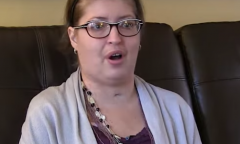By KM Diaz, | March 02, 2017

A collective term for blood diseases is called “bleeding disorder.”
To extend "Hemophilia Awareness Month," March celebrates "Bleeding Disorders Awareness Month."
The month of March is the second-ever celebration of bleeding disorders. This is to share and bring awareness to people about the rare bleeding disorders and other blood-related problems common to health.
Like Us on Facebook
A collective term for blood diseases is called "bleeding disorder." It affects the regulation of blood which leads to poor blood clotting. Clotting has an important role in the blood, the term is also known as coagulation. The blood in being converted from a liquid into solid form, this action frequently occurs during injuries to prevent massive blood loss. If a person has a bleeding disorder, blood will not clot which leads to prolonged bleeding time of the patient.
The bleeding disorder can also cause an adverse reaction inside and outside the body. Non-stop bleeding occurs when an excessive amount of blood leave the body. The bleeding may also affect vital organs and it is fatal if it occurs in the brain. Because March is Bleeding Disorders Awareness Month, Hemophilia and other rare bleeding problems are discussed.
Hemophilia
According to Hemophilia Federation of America, Hemophilia is a very rare bleeding condition which only affects 20,000 Americans. However, even though it is a rare disease, this is the most common among bleeding disorders. Males are mostly affected by this disease because it is associated with the chromosome X.
Hemophilia has four types, they are classified depending on the severity and protein that is not present in the blood. But it doesn't matter which type of Hemophilia is present because patients do not produce excessive bleeding, rather, their bleeding time is longer than usual. Hemophilia is usually diagnosed during birth if it is present in the family.
Centers for Disease Control and Prevention identifies the signs and symptoms of Hemophilia these are: joint bleeding that causes stiffness and pain, bleeding after vaccines or dental work, the presence of blood in urine and stool, and non-stop nosebleeds.
Hereditary Hemorrhagic Telangiectasia (HHT)
This is a genetic disorder that does not properly develop the blood vessels. One of the most common symptoms of the disease is frequent nose bleeding. Other symptoms include an abnormality in the blood vessels which appears in the skin and can cause internal bleeding. According to CDC, there is no available cure for the disease; however, there is an available effective treatment.
Thalassemia
This bleeding disorder occurs if the body does not produce enough hemoglobin; a vital protein in the red blood cells and associated in the production of oxygen in the blood. Thalassemia is also an inherited bleeding disorder and usually identified due to severe anemia, although it severities may depend on according to person and situation. The disease is common among people came from Mediterranean countries, people from Africa, Middle East, and Asia, according to CDC.
Von Willebrand Disease (VWD)
VWD is a rare bleeding disorder that is usually found 1 percent in the population of US. The name of the disease came from one of the proteins present in the blood called "von Willebrand factor," this protein helps the blood to stop the bleeding. This is also inherited in which the blood in not properly clotted.
VWD affects men and women, but women will easily identify the disease because of excessive bleeding during menstruation and after childbirth. According to CDC, other signs and symptoms include non-stop nosebleeds, easily to get a bruise, and a long period of bleeding during injuries, surgeries, and dental works.
-
Use of Coronavirus Pandemic Drones Raises Privacy Concerns: Drones Spread Fear, Local Officials Say

-
Coronavirus Hampers The Delivery Of Lockheed Martin F-35 Stealth Fighters For 2020

-
Instagram Speeds Up Plans to Add Account Memorialization Feature Due to COVID-19 Deaths

-
NASA: Perseverance Plans to Bring 'Mars Rock' to Earth in 2031

-
600 Dead And 3,000 In The Hospital as Iranians Believed Drinking High-Concentrations of Alcohol Can Cure The Coronavirus

-
600 Dead And 3,000 In The Hospital as Iranians Believed Drinking High-Concentrations of Alcohol Can Cure The Coronavirus

-
COVID-19: Doctors, Nurses Use Virtual Reality to Learn New Skills in Treating Coronavirus Patients











